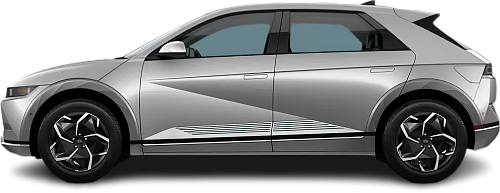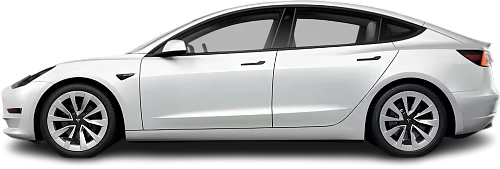Global EV Comparison: Hyundai Ioniq 5 Long Range AWD vs Tesla Model 3 Standard Range
Struggling to Decide? Let AI Help!
Your AI Summary Is Ready!
General Info
Since both vehicles have been discontinued, they are now only available on the used car market. You can get the Hyundai Ioniq 5 Long Range AWD (2022-2024) for as low as €29450, while the Tesla Model 3 Standard Range (2019-2020) begins at €18790.
The Hyundai Ioniq 5 Long Range AWD (2022-2024) is a SUV, whereas the Tesla Model 3 Standard Range (2019-2020) is a Sedan.
| Property | Hyundai Ioniq 5 Long Range AWD | Tesla Model 3 Standard Range |
|---|---|---|
| Years of Production | 2022-2024 | 2019-2020 |
| Current Status | Discontinued | Discontinued |
| Country of Manufacture | Indonesia, Singapore, South Korea | China, Germany, USA |
| Body Style | SUV | Sedan |
| Market Availability | EU, USA | EU, USA |
| Price Europe (Used) | €29450 | €18790 |
| GCC Score | 7 | 6.1 |
Range and Efficiency
While the Hyundai Ioniq 5 Long Range AWD (2022-2024) offers a longer real-world range and a bigger battery, it is less energy-efficient than the Tesla Model 3 Standard Range (2019-2020).
| Property | Hyundai Ioniq 5 Long Range AWD | Tesla Model 3 Standard Range |
|---|---|---|
| Range (EPA) | 418 km | 354 km |
| Range (WLTP) | 481 km | - Range (WLTP) |
| Range (GCC) | 405 km | 336 km |
| Battery Capacity (Nominal) | 77.4 kWh | 60 kWh |
| Battery Capacity (Usable) | 74 kWh | 57.5 kWh |
| Efficiency per 100 km | 18.3 kWh/100 km | 17.1 kWh/100 km |
| Efficiency per kWh | 5.47 km/kWh | 5.84 km/kWh |
| Range and Efficiency Score | 6.8 | 6.2 |
Charging
The Hyundai Ioniq 5 Long Range AWD (2022-2024) features an advanced 800-volt architecture, whereas the Tesla Model 3 Standard Range (2019-2020) relies on a standard 400-volt system.
The Hyundai Ioniq 5 Long Range AWD (2022-2024) offers faster charging speeds at DC stations, reaching up to 233 kW, while the Tesla Model 3 Standard Range (2019-2020) maxes out at 170 kW.
Both vehicles are equipped with the same on-board charger, supporting a maximum AC charging power of 11 kW.
| Property | Hyundai Ioniq 5 Long Range AWD | Tesla Model 3 Standard Range |
|---|---|---|
| Max Charging Power (AC) | 11 kW | 11 kW |
| Max Charging Power (DC) | 233 kW | 170 kW |
| Architecture | 800 V | 400 V |
| Charge Port | CCS Type 2 | CCS Type 2 (Tesla) |
| Charging Score | 7.7 | 5.6 |
Performance
The Tesla Model 3 Standard Range (2019-2020) is rear-wheel drive, while the Hyundai Ioniq 5 Long Range AWD (2022-2024) offers an all-wheel drive system.
The Hyundai Ioniq 5 Long Range AWD (2022-2024) boasts greater motor power and accelerates faster from 0 to 100 km/h.
| Property | Hyundai Ioniq 5 Long Range AWD | Tesla Model 3 Standard Range |
|---|---|---|
| Drive Type | AWD | RWD |
| Motor Type | PMSM (front), PMSM (rear) | PMSM |
| Motor Power (kW) | 239 kW | 208 kW |
| Motor Power (hp) | 320 hp | 279 hp |
| Motor Torque | 605 Nm | 420 Nm |
| 0-100 km/h | 5.1 s | 6.1 s |
| Top Speed | 185 km/h | 225 km/h |
| Performance Score | 5.3 | 5 |
Dimensions
The Hyundai Ioniq 5 Long Range AWD (2022-2024) is wider and taller, but about the same length as the Tesla Model 3 Standard Range (2019-2020).
The Hyundai Ioniq 5 Long Range AWD (2022-2024) boasts a more extended wheelbase.
| Property | Hyundai Ioniq 5 Long Range AWD | Tesla Model 3 Standard Range |
|---|---|---|
| Length | 4635 mm | 4695 mm |
| Width (with Mirrors) | 2152 mm | 2088 mm |
| Width (w/o Mirrors) | 1890 mm | 1850 mm |
| Height | 1605 mm | 1445 mm |
| Wheelbase | 3000 mm | 2875 mm |
Cargo and Towing
The Tesla Model 3 Standard Range (2019-2020) features a larger trunk, but the Hyundai Ioniq 5 Long Range AWD (2022-2024) offers greater maximum cargo capacity when the rear seats are folded.
Both models feature a convenient frunk (front trunk), providing additional storage space.
The Hyundai Ioniq 5 Long Range AWD (2022-2024) is better suited for heavy loads, offering a greater towing capacity than the Tesla Model 3 Standard Range (2019-2020).
| Property | Hyundai Ioniq 5 Long Range AWD | Tesla Model 3 Standard Range |
|---|---|---|
| Number of Seats | 5 | 5 |
| Curb Weight | 2120 kg | 1611 kg |
| Cargo Volume (Trunk) | 527 l | 561 l |
| Cargo Volume (Max) | 1578 l | 1235 l |
| Cargo Volume (Frunk) | 24 l | 88 l |
| Towing Capacity | 1600 kg | 1000 kg |
| Cargo and Towing Score | 6.9 | 5.1 |




